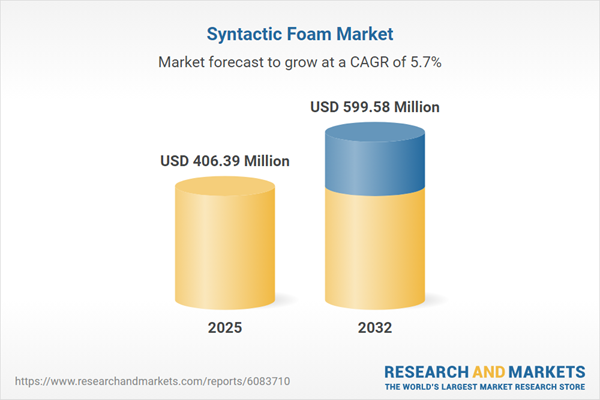Speak directly to the analyst to clarify any post sales queries you may have.
Syntactic foam materials are emerging as a strategic solution for weight reduction and structural optimization in industries that demand resilient, high-performance composites. Their integration into transportation, energy, and infrastructure is unlocking efficiency and sustainability gains for forward-thinking organizations.
Market Snapshot: Syntactic Foam Market Growth Trajectory
The syntactic foam market grew from USD 385.64 million in 2024 to USD 406.39 million in 2025. Sustaining a compound annual growth rate (CAGR) of 5.67%, the market is projected to reach USD 599.58 million by 2032. This steady expansion reflects robust adoption across multiple sectors and supports rising investment in advanced lightweight material systems.
Scope & Segmentation: Syntactic Foam Market Coverage
This report delivers comprehensive segmentation analysis of the global syntactic foam market. Insights include granular breakdowns by product design, material innovations, application diversity, manufacturing process, and distribution channels. Regional intelligence highlights strategic opportunities and deployment trends.
- Product Types: Single-phase syntactic foam; two-phase syntactic foam; three-phase syntactic foam
- Material Types: Ceramic microspheres; glass microspheres; polymeric microspheres
- Density: Low-density; medium-density; high-density syntactic foams
- Manufacturing Processes: Compression molding; extrusion molding; injection molding
- Applications: Aerospace and defense; automotive; construction; marine; sports and leisure; acoustic insulation; buoyancy material; structural reinforcement; thermal insulation; vibration damping
- Distribution Channels: Offline sales; online sales via brand websites; e-commerce platforms
- Regions Covered: Americas (US, Canada, Mexico, Brazil, Argentina, Chile, Colombia, Peru); Europe, Middle East & Africa (UK, Germany, France, Russia, Italy, Spain, Netherlands, Sweden, Poland, Switzerland, UAE, Saudi Arabia, Qatar, Turkey, Israel, South Africa, Nigeria, Egypt, Kenya); Asia-Pacific (China, India, Japan, Australia, South Korea, Indonesia, Thailand, Malaysia, Singapore, Taiwan)
Key Takeaways for Decision Makers
- Technological innovation is driving advanced composite variants, enabling tailored solutions for specific sector needs such as defense, marine, and automotive components.
- Sustainability mandates are shaping R&D, with bio-based and recyclable foam materials gaining traction among regional manufacturers and global suppliers.
- Digital engineering and simulation tools are streamlining foam prototyping, supporting faster adaptation to evolving customer requirements and performance benchmarks.
- Shifting procurement strategies are mitigating supply risks, with companies fostering resilient networks and considering vertical integration to secure critical inputs.
- Collaboration between material developers, OEMs, and design consultancies is accelerating the launch of function-driven syntactic foam solutions for new end-use cases.
United States Tariff Impact
In 2025, the introduction of tariffs on imported microspheres and related precursors disrupted global syntactic foam trade. Manufacturers responded by revising sourcing models, evaluating regional reshoring, and pursuing supply diversification. This dynamic has encouraged innovation in formulations less reliant on tariff-affected components and emphasized the strategic importance of resilient supply chains and localized production capabilities.
Research Methodology & Data Sources
Findings are drawn from a combination of primary interviews with industry executives and technical specialists, cross-referenced with corporate filings, reputable trade sources, and regulatory documentation. An independent validation panel has reviewed all analytics and segment definitions to ensure industry relevance.
Why This Report Matters
- Supports strategic planning with authoritative coverage of market developments, key drivers, and evolving use cases.
- Enables investment prioritization through the analysis of regional trends, supply risks, and technological advancements.
- Delivers actionable intelligence for procurement, R&D strategy, and market expansion efforts in the syntactic foam sector.
Conclusion & Strategic Outlook
Syntactic foam continues to advance in scope and sophistication, underpinned by technology progress and proactive supply chain strategies. Understanding these shifts positions market leaders to optimize portfolios, strengthen resilience, and capitalize on new growth opportunities.
Table of Contents
3. Executive Summary
4. Market Overview
7. Cumulative Impact of Artificial Intelligence 2025
Companies Mentioned
The companies profiled in this Syntactic Foam market report include:- 3M Company
- Acoustic Polymers Ltd.
- Advanced Innergy Solutions Limited
- Akzo Nobel N.V.
- ALCEN TECHNOLOGIES PRIVATE LIMITED
- Balmoral Comtec Ltd.
- CMT Materials LLC
- Covestro AG
- DeepWater Buoyancy, Inc.
- Diab Group AB
- Engineered Syntactic Systems, LLC
- ESCO Technologies Inc.
- Hexcel Corporation
- Huntsman Corporation
- Matrix Composites & Engineering
- Mica-Tron Products Corp.
- Nuclead Manufacturing Co. Inc.
- Parker-Hannifin Corporation
- PPG Industries, Inc.
- Precision Acoustics Ltd.
- Resinex Trading S.r.l.
- SynFoam LG by UDC
- Tooling Tech Group
- Trelleborg AB by Yokohama Rubber Co., Ltd.,
- W. R. Grace & Co.-Conn.
Table Information
| Report Attribute | Details |
|---|---|
| No. of Pages | 184 |
| Published | November 2025 |
| Forecast Period | 2025 - 2032 |
| Estimated Market Value ( USD | $ 406.39 Million |
| Forecasted Market Value ( USD | $ 599.58 Million |
| Compound Annual Growth Rate | 5.6% |
| Regions Covered | Global |
| No. of Companies Mentioned | 26 |









